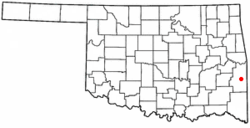Heavener, Oklahoma
| Heavener, Oklahoma | |
|---|---|
| City | |
 Location of Heavener, Oklahoma |
|
| Coordinates: 34°53′21″N 94°36′15″W / 34.88917°N 94.60417°WCoordinates: 34°53′21″N 94°36′15″W / 34.88917°N 94.60417°W | |
| Country | United States |
| State | Oklahoma |
| County | Le Flore |
| Area | |
| • Total | 4.9 sq mi (12.8 km2) |
| • Land | 4.9 sq mi (12.7 km2) |
| • Water | 0.0 sq mi (0.1 km2) |
| Elevation | 554 ft (169 m) |
| Population (2010) | |
| • Total | 3,414 |
| • Density | 696.7/sq mi (268.8/km2) |
| Time zone | Central (CST) (UTC-6) |
| • Summer (DST) | CDT (UTC-5) |
| ZIP code | 74937 |
| Area code(s) | 539/918 |
| FIPS code | 40-33400 |
| GNIS feature ID | 1093640 |
| Website | Chamber of Commerce |
Heavener /ˈheɪvnər/ is a city in Le Flore County, Oklahoma, United States. It is part of the Fort Smith, Arkansas-Oklahoma Metropolitan Statistical Area. It was named for Joseph H. Heavener, who settled in the area about 1877. The population was 3,414 at the 2010 census, an increase of 6.7 percent from 3,201 at the 2000 census. Heavener is notable for the Heavener Runestone just outside the city limits.
Joseph H. Heavener and some other white settlers arrived, secured permits to farm from the Choctaw Indians and settled down to farm. In 1880, Zachary Taylor Ward and his Choctaw Indian wife, Tabitha Hickman Ward, moved their store at Skullyville to the present site of Heavener. Ward died in 1883, and his widow, Tabitha, married Heavener. The couple owned the land on which the town was established. Prior to being named Heavener by a popular vote in 1895, the area was known by several different names, including Prairie of the Tall Grass, Choctaw City, Prairie View, Long Prairie, and Grand Prairie.
Suitable agricultural land around Heavener attracted many farmers as settlers. Other improvements soon followed. A cotton gin and a grist mill were built in town in 1885. In 1896 the Kansas City, Pittsburg and Gulf Railroad built tracks through the town. A post office was established in a boxcar on May 12, 1896 while another boxcar became the train station. In 1900-1901 the Arkansas Western Railroad constructed tracks from Heavener east to Arkansas.
The Curtis Act allowed Heavener to incorporate in Indian Territory in 1898, with Henry Moore elected as the first mayor. The town population was 254 in 1900. After the Kansas City Southern Railway purchased the rail line in 1900, the company established a roundhouse in 1910, making Heavener a division point. By 1910, the population was 780, and continued increasing to 1,850 in 1920.
...
Wikipedia
